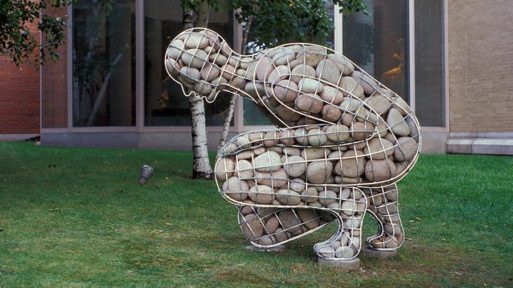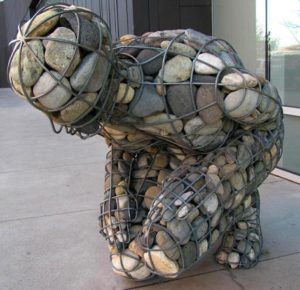Everyone experiences grief in profoundly different ways. Art can assist people during these difficult times. The “Rising Cairn” sculptures by Celeste Roberge exemplify the feelings many people experience during those periods of grief.

Credit: qz.com
Roberge has installed “Rising Cairn” in multiple locales since she created the first sculpture in the late 1980s. There is a permanent one still on display at the Portland Museum of Art in its David E. Shaw and Family Sculpture Park that has been housed there since 2000.
“Rising Cairn” is made from welded steel and roughly 4,000 pounds of granite. Roberge crafted the steel to resemble the outline of her own body; though the sculpture is larger than life-size (the work at the Portland museum measures 58 inches by 54 inches by 40 inches). She then filled the steel grid with rocks of various shapes and sizes.
The most intriguing aspect of each “Rising Cairn” specimen is that Roberge collects the rocks from the same region where the artwork will be displayed. So each reincarnation of the work is quite different.
“Each time, I am surprised that the process is still interesting to me,” Roberge said in 2016. “I noted that they are never the same: different place, different light, different stones, different sitting in the landscape, different energy.”
Human vs. Geologic Time
Celeste Roberge enjoys creating art that interweaves the fleeting nature of human life with the nearly-everlasting endurance of geological time. In “Rising Cairns,” we have rocks that could be millions of years old placed within a steel frame. These materials could potentially stay untouched for millennia, yet they represent a human figure.
Of course, humans don’t last that long. So it’s interesting to consider the human form represented by materials that will far outlast its lifetime. One review of the sculpture said, “The cairns are, in the aggregate, massive and weighty, and seemingly unchanging, at least within our human time frame. Yet, with irony or humor, they help define a human form.”
Cairns are stacks of rocks humans employ for a multitude of reasons. They’re generally constructed to demarcate specific sites, whether it be a trail, a burial site, road, etc. They’ve been in use since at least the Bronze Age, so Celeste Roberge’s modern iterations continue an enduring human practice.
The Weight of Grief
Many people see “Rising Cairn” to be a symbolic representation of grief and the tremendous distress it can cause. Following the death of a loved one, we can feel debilitating weight crashing us down. Rocks are a common depiction of weight, and the fact that these sculptures weigh 4,000 pounds needs no further explanation.

Credit: mymodernmet.com
The way the figure is kneeling seems like the person could have stopped while walking. Perhaps the person felt a sudden bout of weakness and had to stop moving to collect themselves during a grief-stricken moment.
And just as our emotions run wild during times of grief, our physical well-being can also take hits. The representation of rocks as our muscles and innards can be meaningful metaphors.
Celeste Roberge said that she did not create “Rising Cairn” necessarily to symbolize grief.
“I imagine her in the process of rising up from her crouching position…when she is ready,” she explains. “I am not disturbed by individual interpretations of the sculpture because I think it is really wonderful for people to connect with works of art in whatever way is meaningful to them.”
Therein lies the beauty of art: people see what is meaningful to them. Personal interpretation guides the way we view all art. Of course, it’s necessary to take the artist’s original intention into consideration. However, it’s individual reactions, interpretations and feelings that come together to make the entire experience complete.

 Grief and “Rising Cairn” by Celeste Roberge
Grief and “Rising Cairn” by Celeste Roberge


 Recovering Cremation Remains After the Los Angeles Fires
Recovering Cremation Remains After the Los Angeles Fires
 “As Tears Go By” by Marianne Faithfull
“As Tears Go By” by Marianne Faithfull
 “The Sea” by John Banville
“The Sea” by John Banville















